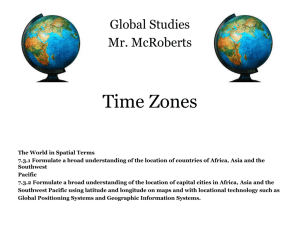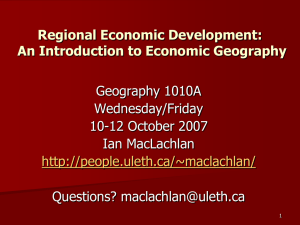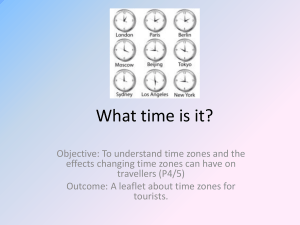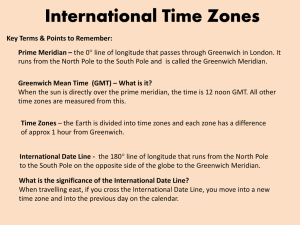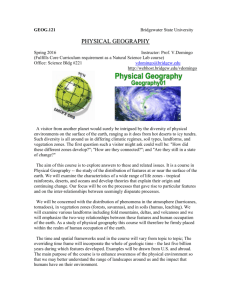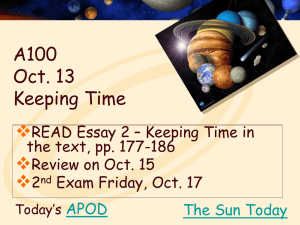Introduction to Geography
advertisement
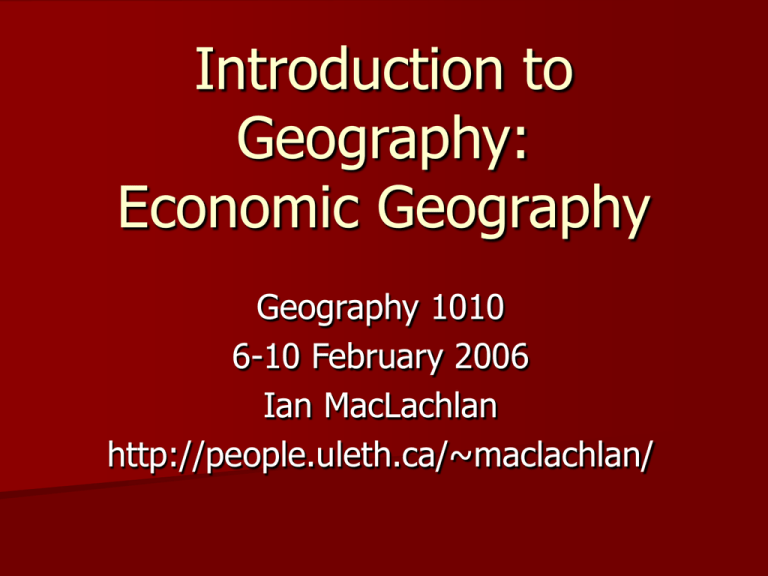
Introduction to Geography: Economic Geography Geography 1010 6-10 February 2006 Ian MacLachlan http://people.uleth.ca/~maclachlan/ What is economic geography? “Economic geography is the study of how people earn their living, how livelihood systems vary by area, and how economic activities are spatially interrelated and linked” – Getis, Getis and Fellman, p. 355 Empirically based: to understand what we see and measure in the real world Theoretically based: generalization and modelling of processes and spatial diversity Economic Geography Week It’s about Time! – Geography of Prime Meridian and time zones – Politics of Prime Meridian and time zones – Telling time Regional Economic Structure – Categories of Economic Activity – Economic Sectors Regional Economic Development – Micro scale – Macro scale What was the key machine of the modern industrial age? Watt’s steam engine Stevenson’s locomotive Jacquard loom Whitney’s cotton gin Colt revolver & interchangeable parts Ford Model T & assembly line What was the key machine of the modern industrial age? The clock, not the steam engine, is the key machine of the modern industrial age. – Lewis Mumford Technics of Civilization World Scale Time Zone Map Solar Time Apparent local time – Centred on solar noon Egyptians divide day and night into 12 equal parts – Temporal hours – unequal – At Thebes, summer solstice, June 21 Daytime temporal hour was 69 minutes Nighttime temporal hour was 51 minutes – March 21 & September 21 – temporal equality – Hipparchus: 24 equal “equinoctial hours” c. 127 BCE Solar Time Temporal hours until 15th century London – Hour ranges from 38-82 minutes Mechanical clocks appear c. 1270 CE Apparent solar time varies from place to place Apparent length of solar day varies in length through the year Mean time introduced by nineteenth century – Celestial adjustment to sun time Time balls Nelson's Monument on Edinburgh’s Calton Hill, visible to ships on the Firth of Forth, 1852. Commemorates Admiral Lord Nelson's death at the Battle of Trafalgar in 1805. Where should time begin? Any arbitrary meridian could be chosen as origin Prime Meridian, Royal Greenwich Observatory Where does time begin? Greenwich Mean Time (GMT) – Solar day varies… – Celestial time became basis for ‘mean time’ – Zulu time (zero hours) ± n UTC = Coordinated Universal Time, 1928 – Atomic clocks – Earth’s rotational speed may be measured – Leap seconds have been added Geography of Time Zones Prime Meridian is basis for UTC UTC is origin of time zones: UTC ± n – E.g. Mountain Standard Time is UTC-7 Centered on meridians: multiples of 15° – 360°/24hours = 15° time zones in theory – Adjacent time zones usually one hour apart. But… – one hour separation is not universal (India UTC+5:30) – shape and longitudinal extent vary Politics and Science! ‘Science-based’ decisions are also… – Political decisions based on economic conditions, social relations, and technological change. Geometrically rational time zones = 15° Geographically rational time zones: 1. Time zone boundaries arranged to coincide with boundaries of human interaction patterns 2. Need to reach consensus – politics Politics of Time Until 1800s, solar time was adequate – High-speed railway transportation – Telegraph and telephone communications British railways started using GMT in 1847 Multiple reference meridians: – Greenwich, Paris, Rome, Copenhagen, Oslo, Pisa, Jerusalem, St. Petersburg, Washington, Philadelphia World system of time zones proposed by Sir Sandford Fleming, 1873 International Meridian Conference, 1884 delegates from 25 nations Agrees on Greenwich as 0° – 24 hour day – Longitude measured as 180° east and west of Greenwich Who abstained? – Did not agree until 1911! The Time Zone System Canada established time zones in 1891 – Provinces may adjust as local needs require Most countries accepted time zones by 1929 Canadian Time Zones in theory TIME ZONES PACIFIC MOUNTAIN CENTRAL EASTERN ATLANTIC NFLD Time Meridian 120°W 105° W 90° W 75° W 60° W 52.5°W Time 1:00 difference 2:00 3:00 4:00 5:00 5:30 UTC -7 -6 -5 -4 -3½ -8 Empirical reality is a little different… 110°W 102°W Exceptions by Local Agreement Source: H. David Matthews and Mary Vincent “It's about TIME” Canadian Geographic http://www.canadiangeographic.ca/Magazine/SO98/geomap.asp World Time Zones How to Tell the Time? I We are in Lethbridge. What time is it in Winnipeg? Lethbridge is UTC-7, Winnipeg is UTC-6 (-6)-(-7)=1 – Winnipeg time is 1 hour ahead of Lethbridge Suppose we are in Shanghai. What time is it in Paris? Shanghai is UTC+9, Paris is UTC+1 (1)-(9)=-8 – Paris time is 8 hours behind Shanghai How to Tell the Time? II Suppose we are in Washington D.C. What time is it in Sydney, Australia? Washington is UTC-5, Sydney is UTC+11 (11)-(-5)=16 – Sydney time is 16 hours ahead of Washington Suppose we are in Bangkok. What time is it in Honolulu? Bangkok is UTC+7, Honolulu is UTC-10 – (-10)-(7)=-17 – Honolulu time is 17 hours behind Bangkok Daylight Saving Time UTC+1 – But DST depends on latitude and – Local preferences e.g. Saskatchewan, Arizona, Hawaii Daylight Saving Time World War I – Sommerzeit 1916 – British Summer Time 1916 – U.S. & Canada Daylight Saving Time 1918 World War II – British Double Summer Time U.S. Uniform Time Act of 1966 Urban – rural division Daylight Saving Time 1974 OPEC oil embargo – Nixon experiment, year-round DST 1986 – extra month of DST – $150 million for barbecue industry – $200-400 million for golf industry Savings in lighting cost Added cost in petroleum for daylight driving in longer evenings No saving in energy use! – See Michael Downing, Tufts University Spring Forward: The Annual Madness of Daylight Savings Time Daylight Saving Time 2007 U.S. will spring ahead the second Sunday in March, three weeks earlier than now. Additionally the clocks will fall back the first Sunday in November, one week later than the current standard. 2007 Alberta’s Daylight Saving Time Act, – Will conform to U.S. Time and Space Themes Time may be defined and measured scientifically But the map of time is a human creation – Political decision – social process – Depends on spatial patterns of human activity – Technology change – social process Time is money! Introduction to Regional Development Structure Growth Structural Change Development Regional Economic Structure Shift from time to space: case study Coalhurst Heuristic Structure Growth Development Structure “the way in which parts are arranged to form a whole” Structure as a framework Structure as a nested hierarchy Economic structure 1. Classification of regional economy into sectors 2. Measure their size (count, employment, value) 3. Describe components of the structure Commercial Structure of a Service Centre: The Economic Geography of Coalhurst Town of Coalhurst: 1,493 in 2004 Services: 1 1 1 1 1 1 1 1 post office elementary school high school bar/restaurant Royal Canadian Legion gas station and convenience store specialized lumber distributor manufacturer of cement lawn ornaments Is Coalhurst Growing? Year Population Dwellings Population 2004 1,493 Population 2002 1,476 Population 2001 1,475 Population 2000 1,465 Population 1999 1,465 Population 1996 1,439 470 Population 1991 1,322 415 510 Percent change 1991-1996 8.9 13.3 Percent change 1996-2001 2.5 8.5 Is Coalhurst Developing? Commercial Structure of Coalhurst in 1989 Town of Coalhurst: 1,289 Services: 1 1 1 1 1 1 1 1 1 post office elementary school high school bar/restaurant Royal Canadian Legion gas station and convenience store (new) convenience store specialized lumber distributor manufacturer of cement lawn ornaments A different kind of regional structure… Coalhurst’s Demographic Structure, 2003 Suppose Coalhurst were to Grow... Town of Coalhurst: 1,493,000 Services: 1,000 1,000 1,000 1,000 1,000 1,000 1,000 1,000 post offices elementary schools high schools bar/restaurants Royal Canadian Legions gas station and convenience stores specialized lumber distributors fountain manufacturers What would be missing? What have we learned from Coalhurst? Experienced distinction between growth and development Calculated growth rates Structure in the context of economic geography: Commercial structure Little change between 1989 and 2004 Demographic Structure Family-oriented Slow growth but no evidence of structural change How can this community be sustainable? Understanding locations in space: Site and Situation Site - absolute locational concept Physical characteristics Economic and cultural attributes Situation – relative locational concept External relationships with other places …location relative to other features Markets Services Employment How Can We Understand the location of Coalhurst? Site: Undifferentiated prairie Shallow coal deposit Coal mine closed in 1936 Situation: 10 minutes from Lethbridge Suburban satellite of Lethbridge Employment Shopping Services Residents choose Coalhurst for its lack of development Dependency relationship is an asset

